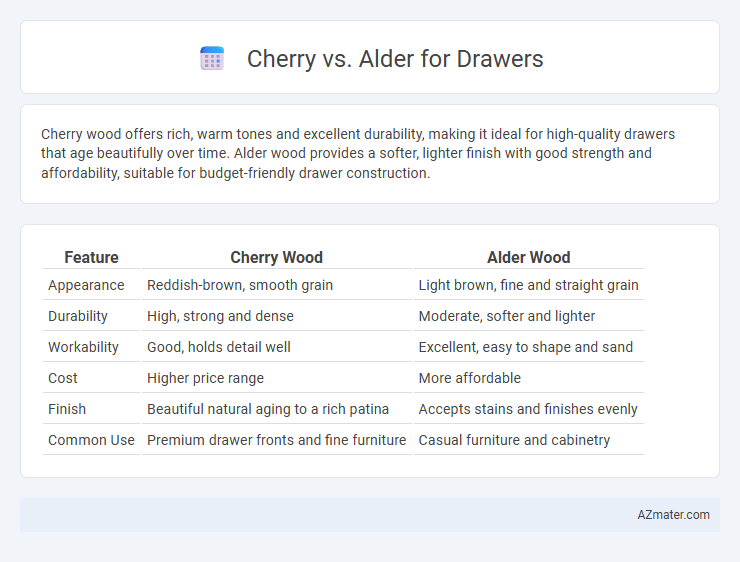Cherry wood offers rich, warm tones and excellent durability, making it ideal for high-quality drawers that age beautifully over time. Alder wood provides a softer, lighter finish with good strength and affordability, suitable for budget-friendly drawer construction.
Table of Comparison
| Feature | Cherry Wood | Alder Wood |
|---|---|---|
| Appearance | Reddish-brown, smooth grain | Light brown, fine and straight grain |
| Durability | High, strong and dense | Moderate, softer and lighter |
| Workability | Good, holds detail well | Excellent, easy to shape and sand |
| Cost | Higher price range | More affordable |
| Finish | Beautiful natural aging to a rich patina | Accepts stains and finishes evenly |
| Common Use | Premium drawer fronts and fine furniture | Casual furniture and cabinetry |
Overview: Cherry vs Alder Wood
Cherry wood is prized for its rich, warm reddish-brown tone that deepens with age, providing a classic and elegant appearance for drawers. Alder wood offers a lighter, more uniform grain with subtle reddish hues, making it ideal for a clean, contemporary look at a lower cost. Cherry is harder and more durable than alder, which is softer and easier to work with but less resistant to dents and scratches.
Physical Characteristics Comparison
Cherry wood features a fine, straight grain with a smooth texture that darkens to a rich reddish-brown over time, enhancing drawer aesthetics. Alder has a softer, more uniform grain with a lighter tan to reddish-brown color that remains consistent, making it easier to stain for varied finishes. Both woods offer durability for drawers, but cherry's hardness and natural patina provide superior resistance to dents and scratches compared to alder's softer composition.
Color and Grain Differences
Cherry wood features a rich, warm reddish-brown color that deepens over time, offering a smooth and consistent grain with subtle patterns, making it ideal for elegant, high-end drawers. Alder wood presents a lighter, more natural tan to reddish-brown hue with a straight, fine grain that can occasionally exhibit knots, providing a rustic and casual appearance suitable for more affordable or farmhouse-style drawers. The contrast in color and grain between cherry and alder significantly influences the aesthetic and design choice for drawer construction.
Durability and Strength
Cherry wood offers excellent durability with a Janka hardness rating of approximately 950, making it resistant to dents and scratches in drawer construction. Alder wood, while softer with a Janka rating around 590, provides good strength but may show wear more quickly under heavy use. Choosing cherry ensures longer-lasting sturdiness and a more resilient drawer structure compared to alder.
Workability and Ease of Machining
Cherry wood offers excellent workability and smooth machining due to its fine, straight grain and moderate hardness, making it ideal for drawer construction with reduced tool wear. Alder is also easy to machine, featuring a soft texture and consistent grain that allows for clean cuts and minimal sanding effort, though it is slightly less durable than cherry. Both woods provide reliable workability, but cherry's balance of hardness and smooth finish often results in superior precision and durability in drawer applications.
Cost and Availability
Cherry wood for drawers is generally more expensive due to its rich color, fine grain, and slower growth rate, making it a premium choice often sourced from North America. Alder offers a more affordable option with consistent availability, characterized by its lighter color and softer texture, commonly harvested from the western United States. Cost differences stem from Cherry's scarcity and aging process enhancing its value, while Alder's abundance ensures steady market supply and budget-friendly pricing.
Finishing and Staining Properties
Cherry wood offers a smooth surface that accepts stains evenly, enhancing its natural reddish-brown hues, while its fine grain allows for a sleek, polished finish ideal for elegant drawers. Alder wood, being softer with a more open grain, readily absorbs stains but may require additional sanding to prevent blotching, resulting in a rustic or matte finish favored in casual or cottage-style cabinetry. Both woods respond well to clear finishes, but Cherry's dense structure provides a more durable, glossy coat compared to Alder's tendency to develop a softer sheen.
Environmental Impact and Sustainability
Cherry wood, sourced primarily from North American forests, has a moderate environmental impact due to selective harvesting practices that support sustainable forest management, promoting biodiversity and reducing deforestation. Alder, often harvested from fast-growing, managed plantations, offers a more sustainable option as its rapid growth cycle allows for quicker replenishment and lower carbon footprint compared to slower-growing hardwoods. Both woods benefit from certifications like FSC (Forest Stewardship Council), which ensures responsible sourcing, but alder generally aligns better with eco-friendly drawer construction due to its enhanced renewability and minimal habitat disruption.
Best Applications for Drawer Construction
Cherry wood offers a smooth texture and rich color, making it ideal for high-end, visually appealing drawers in bedroom furniture and fine cabinetry. Alder wood provides a softer, more affordable option with good workability, best suited for casual or rustic drawer construction where budget and ease of finishing are priorities. Both woods perform well in drawer construction, but Cherry excels in durability and aging beauty, while Alder is favored for its versatility and cost-effectiveness.
Pros and Cons Summary: Cherry vs Alder
Cherry wood offers a rich, warm color that deepens over time, making it highly desirable for drawer construction due to its durability and smooth grain. Alder provides a lighter, more consistent tone with a softer grain, making it easier to work with and more affordable, but it is less dense and may dent more easily. While Cherry excels in longevity and aesthetic aging, Alder stands out for cost-effectiveness and versatility in finishing options.

Infographic: Cherry vs Alder for Drawer
 azmater.com
azmater.com